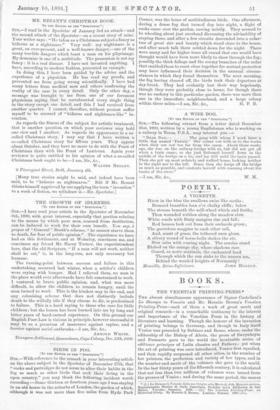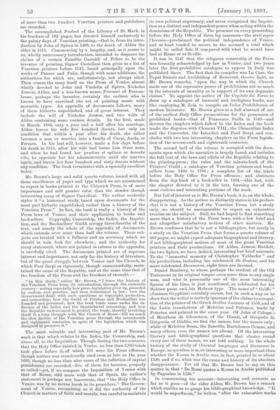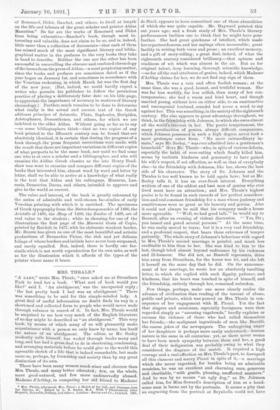BOOKS.
THE VENETIAN PRINTING-PRESS.*
THE almost simultaneous appearance of Signor Castellani's La Stampa in Venezia and Mr. Horatio Brown's Venetian Printing-Press—each of them a work of great merit and original research—is a remarkable testimony to the interest and importance of the Venetian Press in the history of literature and learning. Though the honour of the invention of printing belongs to Germany, and though in Italy itself Venice was preceded by Subiaco and Rome, where, under the editorship of the Bishop of Aleria, the press of Swcynheym and Pannartz gave to the world the invaluable series of editiones principes of Latin classics and Fathers ; yet when the art of printing was once introduced, Venice first equalled, and then rapidly surpassed all other cities, in the number of her printers, the perfection and variety of her types, and in the number and merit of the volumes she gave to the world. In the last thirty years of the fifteenth century, it is calculated that not less than two millions of volumes were issued from the presses of Venice ; and during the same period, the names • (1.) La Stamp(' in Venezia dada sun Origin, alio ?torte di Aldo Manutio senior,. Regionamento Storioo di Carlo Cinstellaul, Prorotto della Biblioteen de San Marco. Venezia Onganin, 1R89.—(2.) The Venetian Printing•Press : an Historical Study. By Horatio N. Brown. London; ',Timm°. 1891 [ow]. of more than two hundred Venetian printers and publishers are recorded.
The accomplished Prefect of the Library of St. Mark, in his brochure of 182 pages, has devoted himself exclusively to the palmy days of Venetian printing,—that is, from its intro- duction by John of Spires in 1469, to the death of Aldus the elder in 1515. Commencing by a lengthy, and, as it seems to us, wholly unnecessary introduction, intended to disprove the claims of a certain Pamfilio Castaldi of Feltre to be the inventor of printing, Signor Castellani then gives us a list of Venetian printers before 1515, based principally upon the works of Panzer and Fulin, though with some additions, the authorities for which are, unfortunately, not always cited. Then comes the essay itself on the Press of Venice, almost wholly devoted to John and Vindelin of Spires, Nicholas Jenson, Aldus, and a less-known name, Petrucci of Fossom- brone, perhaps the inventor, certainly the earliest who is known to have exercised the art of printing music with moveable types. An appendix of documents follows, many of them hitherto unpublished, and of great interest. They include the will of Nicholas Jenson, and two wills of Aldus containing some curious details. In the first, made in March, 1506, only a year and a half after his marriage, Aldus leaves his wife five hundred ducats, but only on condition that within a year after his death, she either becomes a nun or marries into a family of Carpi, Asola, or Ferrara. In his last will, however, made a few days before his death in 1515, after his wife had borne him three eons, and when he had found her prudens et optima ac honestm vibe, he appoints her his administratrix until she marries again, and leaves her four hundred and sixty ducats without any condition. The book terminates with a specially excellent index.
Mr. Brown's large and solid quarto volume, issued with all those excellences of paper and type which we are accustomed to expect in books printed at the Chiswick Press, is of more importance and still greater value than the slender though interesting essay of Signor Castellani. The author modestly styles it "a historical study, based upon documents for the most part hitherto unpublished, rather than a history of the Venetian Press." In fact, the book is really a history of the Press laws of Venice, and their application to books and booksellers. Copyright, Censorship, the Index, the Inquisi- tion, and the Booksellers' Guild, occupy three-fourths of the text, and nearly the whole of the appendix of documents, which extends over more than half the volume. These sub- jects are treated with a fullness and an accuracy which we should in vain look for elsewhere ; and the authority for every statement, where not printed in ecetenso in the appendix, is carefully cited. The documents printed are of supreme interest and importance, not only for the history of literature, but of the great struggle between Venice and the Church, in which Paul Sarpi so vigorously, though unsuccessfully, main- tained the cause of the Republic, and at the same time that of the freedom of the Press and the freedom of thought :— ":In this study," writes Mr. Brown, "I trace the history of the Venetian Press from its introduction, through the sixteenth century—noting especially how press legislation grow up, preceded by custom and practice, and then formulated in law; how the Government dealt with such questions as copyright, protection, and censorship ; how the Guild of Printers and Booksellers was founded and governed ; how the book trade came under the in- fluence of the Index and the Inquisitorial censorship, and how the Republic endeavoured to protect the trade, thereby involving itself in a long struggle with the Church of Rome—till we reach the slow decline of the Venetian press through the seventeenth and eighteenth centuries, in spite of the legislation which was designed to preserve it."
The most valuable and interesting part of Mr. Brown's work is that which relates to the Index, the Censorship, and, above all, to the Inquisition. Though during the two centuries that the Holy Office existed in Venice, no less than 2,910 trials took place before it, of which 191 were for Press offences, though torture was occasionally used even as late as the year 1695, though no less than nine eases of the infliction of capital punishment are recorded—fiVe of them for heresies, properly so called—yet, if we compare the Inquisition of Venice with that of Rome, still more with that of Spain, the author's statement is perhaps not inaccurate, that "the Holy Office in Venice was by no means harsh in its procedure." The Govern- ment of Venice, recognising as it did the authority of the Church in matters of faith and morals, was careful to maintain its own political supremacy, and never recognised the Inquisi- tion as a distinct and independent power when acting within the dominions of the Republic. The presence on every proceeding before the Holy Office of three lay assessors—the aavii sopra l'heresia—proclaimed the political independence of Venice, and at least tended to secure to the accused a trial which might be called fair, if compared with what he would have had at Rome or at Seville.
It was in 1547 that the religious censorship of the Press was formally acknowledged by law in Venice, and two years. later the first prohibitive catalogue to appear in Italy was published there. The fact that its compiler was La Casa, the Papal Nuncio and Archbishop of Benevent, throws light, as Mr. Brown remarks, "upon the way in which the Church made use of the repressive power of prohibitions not so much. in the interests of morality as in support of its own dogmatic claims." To appoint the author of the Capitolo del Porno to draw up a catalogue of immoral and irreligious books, was like employing M. Zola to compile an Index Prohibitorum of modern literature. Mr. Brown gives us a full abstract of one of the earliest Holy Office prosecutions for the possession of prohibited books—that of Francesco Stella in 1549—and devotes the chapters which folio* to the Index and the book trade, the disputes with Clement VIII., the Clementine Index and the Concordat, the Interdict and Paul Sarpi, and con- cludes with two less interesting chapters on the Press legisla- tion of the seventeenth and eighteenth centuries.
The second half of the volume is occupied with the docu- ments upon which the narrative is largely based, and includes. the full text of the laws and edicts of the Republic relating to the printing-press ; the rules and the minute-book of the Printers' Guild ; a catalogue of Venetian printers and book- sellers from 1469 to 1796 ; a complete list of the trials. before the Holy Office for Press offences ; and abstracts. from the day-book of a bookseller in 1484,—this last, with, the chapter devoted to it in the text, forming one of the most curious and interesting portions of the work.
But full of interest as is Mr. Brown's book, it is, on the whole, disappointing. As the author so distinctly states in his preface that it is not a. history of the Venetian Press, but a study only, we should be unreasonable to expect an exhaustive treatise on the subject. Still, we had hoped to find something- more than a history of the Press laws, with a few brief and not altogether satisfactory notices of other matters. Mr.. Brown confesses that he is not a bibliographer, but surely in a study on the Venetian Press that forms a quarto volume of 463 pages, we might expect adequate biographical and literary, if not bibliographical notices of moat of the great Venetian printers and their productions. Of Aldus, Jenson, Ratdolt,. the two Spires, we have, indeed, interesting but brief accounts. To the "immortal memory of Christopher Valdarfer " and his productions, including his celebrated De Orators, and his more celebrated Decameron, eight lines are devoted.
Daniel Bomberg, to whom perhaps the student of the Old Testament in its original tongue owes more than to any single- man, and who is personally one of the most interesting- figures of his time, is just mentioned, as celebrated for his Hebrew press and his Hebrew type. The name of " Griffo " (Joannes Gryphine) certainly occurs, but in such a way as to• show that the writer is entirely ignorant of the claims to recogni- tion of the printer of the Greek Oeellua Lucanus of 1559, and of the Latin translations of Meletius and Polemon, made by Petreius, and printed in the same year. Of John of Cologn( of Manthem de Gberetzen, of the Giunti, of Gregorio de Gregoriis, of Giolito, we find the names, but the names only ; while of Melchior Sessa, the Zanettis, Bartolomeo Cesano, and many others, even the names are absent. Of the interesting.• literary and bibliographical questions that cluster round every one of these names, we are told nothing. In the whole history of the study of Oriental languages and literature in Europe, no question is mare interesting or more important than whether the Koran in Arabic was, in fact, printed in or about 1580, and if so, what was the cause and history of its absolute disappearance. Yet all that Mr. Brown has to say on this matter is, that " De Rossi quotes a Koran in Arabic published by Paganino in 1530."
In commencing his account—interesting and. accurate as far as it goes—of the elder Aldus, Mr. Brown has a remark which enables us to gauge his bibliographical knowledge. "It would be superfluous," he writes, "after the exhaustive works of Renoutercl, Didot, Baschet, and others, to dwell at length on the life and labours of the great scholar and printer Aldus Manutius." So far are the works of Renouard and Didot from being exhaustive—Baschet's book, though most in- teresting and valuable, does not claim to be so, and is, indeed, little more than a collection of documents—that each of them has missed much of the most significant literary and biblio- graphical matter in the prefaces to the very books they take in hand to describe. Neither the one nor the other has been successful in unravelling the obscure and confused chronology of the issues from the press of Aldus,—a moat perplexing matter, since the books and prefaces are sometimes dated as if the year began on January 1st, and sometimes in accordance with the Venetian reckoning, in which March 1st was the first day of the new year. (But, indeed, we could hardly expect a writer who permits his publisher to follow the pernicious practice of placing a deliberately false date on his title-page, to appreciate the importance of accuracy in matters of literary chronology.) Further, much remains to be done to determine what really is the actual and correct text of the Greek eclitiones principes of Aristotle, Plato, Sophocles, Euripides, Aristophanes, Demosthenes, and others, for which we are indebted to the elder Aldus. Without going so far as to say —as some bibliographers think—that no two copies of any book printed in the fifteenth century can be found that are absolutely identical, it is certain that during the progress of a book through the press frequent corrections were made, with the result that there are important variations in different copies of what purports to be the same book, nor until we find some one who is at once a scholar and a bibliographer, and who will examine the Aldine Greek classics as the late Henry Brad- shaw was wont to examine and compare different copies of the books that interested him, almost word by word and letter by letter, shall we be able to arrive at a knowledge of what really is the text that Aldus and his colleagues, Musurus, Las- earls, Demetrius Ducas, and others, intended to approve and give to the world as correct.
The value and interest of the book is greatly enhanced by the series of admirable and well-chosen fac-similes of early Venetian printing with which it is enriched. The specimens of Greek typography from the BatTachomyonicichia of 1486, the Aristotle of 1495, the 2E'sop of 1498, the Suidas of 1499, are of real value to the student ; while in choosing for one of the illustrations the first page of the Mocenici Gesta of Cepio, printed by Ratdolt in 1477, with its elaborate woodcut border, Mr. Brown has given us one of the most beautiful and artistic productions of Bernardus Pictor, the rich and yet delicate foliage of whose borders and initials have never been surpassed, and rarely equalled. But, indeed, there is hardly one fac- simile which is not worth reproduction for its own sake, as well as for the illustration which it affords of the types of the printer whose name it bears.


































 Previous page
Previous page